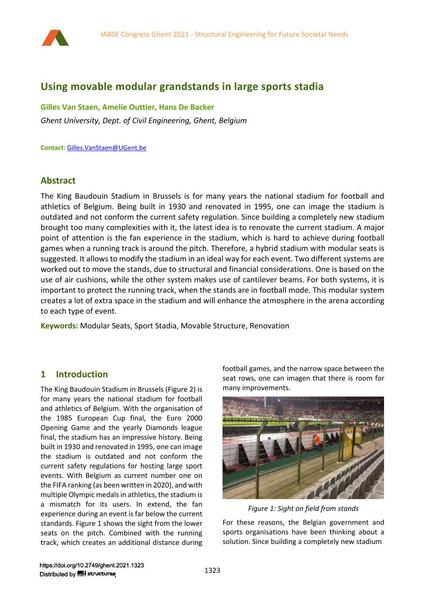Using movable modular grandstands in large sports stadia

|
|
|||||||||||
Détails bibliographiques
| Auteur(s): |
Gilles Van Staen
Amelie Outtier (Ghent University, Dept. of Civil Engineering, Ghent, Belgium) Hans De Backer |
||||
|---|---|---|---|---|---|
| Médium: | papier de conférence | ||||
| Langue(s): | anglais | ||||
| Conférence: | IABSE Congress: Structural Engineering for Future Societal Needs, Ghent, Belgium, 22-24 September 2021 | ||||
| Publié dans: | IABSE Congress Ghent 2021 | ||||
|
|||||
| Page(s): | 1323-1329 | ||||
| Nombre total de pages (du PDF): | 7 | ||||
| DOI: | 10.2749/ghent.2021.1323 | ||||
| Abstrait: |
The King Baudouin Stadium in Brussels is for many years the national stadium for football and athletics of Belgium. Being built in 1930 and renovated in 1995, one can image the stadium is outdated and not conform the current safety regulation. Since building a completely new stadium brought too many complexities with it, the latest idea is to renovate the current stadium. A major point of attention is the fan experience in the stadium, which is hard to achieve during football games when a running track is around the pitch. Therefore, a hybrid stadium with modular seats is suggested. It allows to modify the stadium in an ideal way for each event. Two different systems are worked out to move the stands, due to structural and financial considerations. One is based on the use of air cushions, while the other system makes use of cantilever beams. For both systems, it is important to protect the running track, when the stands are in football mode. This modular system creates a lot of extra space in the stadium and will enhance the atmosphere in the arena according to each type of event. |
||||
| Copyright: | © 2021 International Association for Bridge and Structural Engineering (IABSE) | ||||
| License: | Cette oeuvre ne peut être utilisée sans la permission de l'auteur ou détenteur des droits. |
||||
